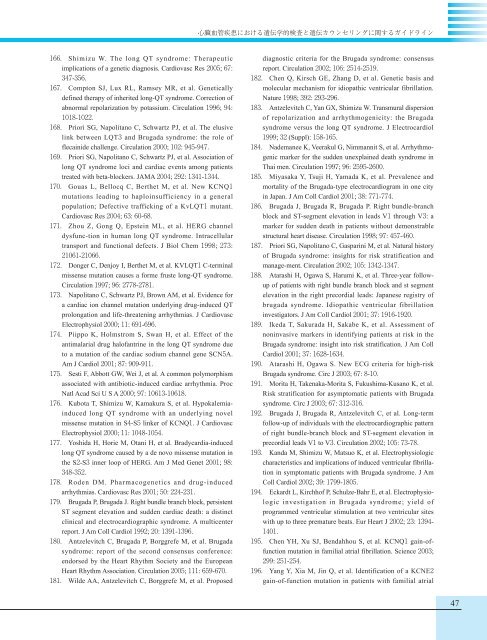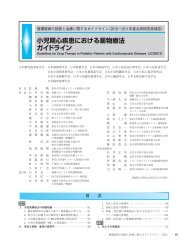å¿èè¡ç®¡ç¾æ£ã«ãããéºä¼å¦çæ¤æ»ã¨éºä¼ã«ã¦ ... - æ¥æ¬å¾ªç°å¨å¦ä¼
å¿èè¡ç®¡ç¾æ£ã«ãããéºä¼å¦çæ¤æ»ã¨éºä¼ã«ã¦ ... - æ¥æ¬å¾ªç°å¨å¦ä¼
å¿èè¡ç®¡ç¾æ£ã«ãããéºä¼å¦çæ¤æ»ã¨éºä¼ã«ã¦ ... - æ¥æ¬å¾ªç°å¨å¦ä¼
You also want an ePaper? Increase the reach of your titles
YUMPU automatically turns print PDFs into web optimized ePapers that Google loves.
心 臓 血 管 疾 患 における 遺 伝 学 的 検 査 と 遺 伝 カウンセリングに 関 するガイドライン166. Shimizu W. The long QT syndrome: Therapeuticimplications of a genetic diagnosis. Cardiovasc Res 2005; 67:347-356.167. Compton SJ, Lux RL, Ramsey MR, et al. Geneticallydefined therapy of inherited long-QT syndrome. Correction ofabnormal repolarization by potassium. Circulation 1996; 94:1018-1022.168. Priori SG, Napolitano C, Schwartz PJ, et al. The elusivelink between LQT3 and Brugada syndrome: the role offlecainide challenge. Circulation 2000; 102: 945-947.169. Priori SG, Napolitano C, Schwartz PJ, et al. Association oflong QT syndrome loci and cardiac events among patientstreated with beta-blockers. JAMA 2004; 292: 1341-1344.170. Gouas L, Bellocq C, Berthet M, et al. New KCNQ1mutations leading to haploinsufficiency in a generalpopulation; Defective trafficking of a KvLQT1 mutant.Cardiovasc Res 2004; 63: 60-68.171. Zhou Z, Gong Q, Epstein ML, et al. HERG channeldysfunc-tion in human long QT syndrome. Intracellulartransport and functional defects. J Biol Chem 1998; 273:21061-21066.172. Donger C, Denjoy I, Berthet M, et al. KVLQT1 C-terminalmissense mutation causes a forme fruste long-QT syndrome.Circulation 1997; 96: 2778-2781.173. Napolitano C, Schwartz PJ, Brown AM, et al. Evidence fora cardiac ion channel mutation underlying drug-induced QTprolongation and life-threatening arrhythmias. J CardiovascElectrophysiol 2000; 11: 691-696.174. Piippo K, Holmstrom S, Swan H, et al. Effect of theantimalarial drug halofantrine in the long QT syndrome dueto a mutation of the cardiac sodium channel gene SCN5A.Am J Cardiol 2001; 87: 909-911.175. Sesti F, Abbott GW, Wei J, et al. A common polymorphismassociated with antibiotic-induced cardiac arrhythmia. ProcNatl Acad Sci U S A 2000; 97: 10613-10618.176. Kubota T, Shimizu W, Kamakura S, et al. Hypokalemiainducedlong QT syndrome with an underlying novelmissense mutation in S4-S5 linker of KCNQ1. J CardiovascElectrophysiol 2000; 11: 1048-1054.177. Yoshida H, Horie M, Otani H, et al. Bradycardia-inducedlong QT syndrome caused by a de novo missense mutation inthe S2-S3 inner loop of HERG. Am J Med Genet 2001; 98:348-352.178. Roden DM. Pharmacogenetics and drug-inducedarrhythmias. Cardiovasc Res 2001; 50: 224-231.179. Brugada P, Brugada J. Right bundle branch block, persistentST segment elevation and sudden cardiac death: a distinctclinical and electrocardiographic syndrome. A multicenterreport. J Am Coll Cardiol 1992; 20: 1391-1396.180. Antzelevitch C, Brugada P, Borggrefe M, et al. Brugadasyndrome: report of the second consensus conference:endorsed by the Heart Rhythm Society and the EuropeanHeart Rhythm Association. Circulation 2005; 111: 659-670.181. Wilde AA, Antzelevitch C, Borggrefe M, et al. Proposeddiagnostic criteria for the Brugada syndrome: consensusreport. Circulation 2002; 106: 2514-2519.182. Chen Q, Kirsch GE, Zhang D, et al. Genetic basis andmolecular mechanism for idiopathic ventricular fibrillation.Nature 1998; 392: 293-296.183. Antzelevitch C, Yan GX, Shimizu W. Transmural dispersionof repolarization and arrhythmogenicity: the Brugadasyndrome versus the long QT syndrome. J Electrocardiol1999; 32 (Suppl): 158-165.184. Nademanee K, Veerakul G, Nimmannit S, et al. Arrhythmogenicmarker for the sudden unexplained death syndrome inThai men. Circulation 1997; 96: 2595-2600.185. Miyasaka Y, Tsuji H, Yamada K, et al. Prevalence andmortality of the Brugada-type electrocardiogram in one cityin Japan. J Am Coll Cardiol 2001; 38: 771-774.186. Brugada J, Brugada R, Brugada P. Right bundle-branchblock and ST-segment elevation in leads V1 through V3: amarker for sudden death in patients without demonstrablestructural heart disease. Circulation 1998; 97: 457-460.187. Priori SG, Napolitano C, Gasparini M, et al. Natural historyof Brugada syndrome: insights for risk stratification andmanage-ment. Circulation 2002; 105: 1342-1347.188. Atarashi H, Ogawa S, Harumi K, et al. Three-year followupof patients with right bundle branch block and st segmentelevation in the right precordial leads: Japanese registry ofbrugada syndrome. Idiopathic ventricular fibrillationinvestigators. J Am Coll Cardiol 2001; 37: 1916-1920.189. Ikeda T, Sakurada H, Sakabe K, et al. Assessment ofnoninvasive markers in identifying patients at risk in theBrugada syndrome: insight into risk stratification. J Am CollCardiol 2001; 37: 1628-1634.190. Atarashi H, Ogawa S. New ECG criteria for high-riskBrugada syndrome. Circ J 2003; 67: 8-10.191. Morita H, Takenaka-Morita S, Fukushima-Kusano K, et al.Risk stratification for asymptomatic patients with Brugadasyndrome. Circ J 2003; 67: 312-316.192. Brugada J, Brugada R, Antzelevitch C, et al. Long-termfollow-up of individuals with the electrocardiographic patternof right bundle-branch block and ST-segment elevation inprecordial leads V1 to V3. Circulation 2002; 105: 73-78.193. Kanda M, Shimizu W, Matsuo K, et al. Electrophysiologiccharacteristics and implications of induced ventricular fibrillationin symptomatic patients with Brugada syndrome. J AmColl Cardiol 2002; 39: 1799-1805.194. Eckardt L, Kirchhof P, Schulze-Bahr E, et al. Electrophysiologicinvestigation in Brugada syndrome; yield ofprogrammed ventricular stimulation at two ventricular siteswith up to three premature beats. Eur Heart J 2002; 23: 1394-1401.195. Chen YH, Xu SJ, Bendahhou S, et al. KCNQ1 gain-offunctionmutation in familial atrial fibrillation. Science 2003;299: 251-254.196. Yang Y, Xia M, Jin Q, et al. Identification of a KCNE2gain-of-function mutation in patients with familial atrial47




